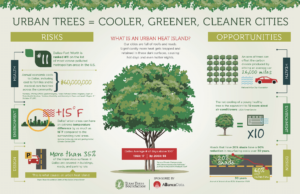How the Urban Heat Island is Impacting North Texas
With the Texas summer in full swing, residents of urban areas are dealing with something their rural counterparts may not: Urban Heat Islands.
The Urban Heat Island (UHI) Effect occurs when built surfaces, like roads, parking lots, and roofs, heat up during the day and slowly release heat throughout the evening and night, resulting in hot days and hotter nights. Lack of vegetation can increase this effect, making cities, such as those in North Texas, especially susceptible.
Impacts of the Urban Heat Island Effect
 Heat islands sound like they have a distinct cut off at the edges, but in reality, it exists on a gradient with some areas being impacted more than others. The more impervious surfaces like roads and roofs, the more the effect heats an area.
Heat islands sound like they have a distinct cut off at the edges, but in reality, it exists on a gradient with some areas being impacted more than others. The more impervious surfaces like roads and roofs, the more the effect heats an area.
City parks, by contrast, can be significantly cooler. Cities can be 1.8–5.4°F warmer than nearby rural areas, during the day, and up to 22°F warmer on clear calm nights. In DFW, for example, the hottest areas of Dallas measured an average high of 101°F and a low of nearly 80°F for five full months of the year.
In areas of severe urban heat, temperatures can reach dangerous levels. Hot environments can cause life-threatening conditions such as dehydration, heat exhaustion and heat stroke.
According to the Center for Disease Control, between 1999 to 2010, 8,081 heat-related deaths were reported in the United States. They also note that the elderly is especially prone to heat-related effects.
How to Reduce Urban Heat Islands
 Trees can have a big impact on urban heat. By providing shade to impervious surfaces, and controlling micro-climates around them through a process called evapotranspiration, trees can cool hot urban areas up to 15°F on hot summer days.
Trees can have a big impact on urban heat. By providing shade to impervious surfaces, and controlling micro-climates around them through a process called evapotranspiration, trees can cool hot urban areas up to 15°F on hot summer days.
Planting trees in the hottest areas with high density residential was found to reduce deaths by more than 20 percent by merely dropping the temperature alone. By moving the benefits of rural vegetation into cities, we can begin to reverse the urban heat island.
